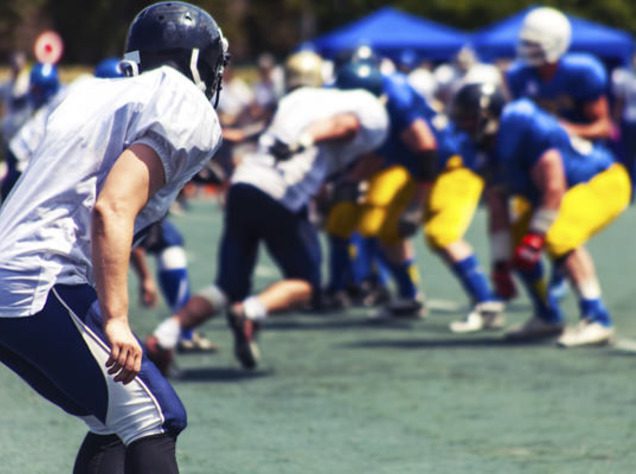On the surface, defensive backs have some of the toughest responsibilities in football. They must try to contain and stay with some of the world’s most explosive athletes while simultaneously reacting on-the-fly. The life of a defensive back spans across many schemes, dreams, and nightmares about opposing wide receivers. If you aspire to be the next Richard Sherman or Patrick Peterson, try digesting some of CoachUp’s best technique tips for defensive backs.
Defensive backs, for those of you that need a quick reminder, is an umbrella term for cornerbacks, safeties, nickelbacks, and dimebacks. Although these positions exist all over the defensive side of field, these players all must do the same thing: guard players and space accurately, efficiently, and without any major mistakes.

Man-To-Man Principles
There are several skills a DB will need to know in order to play some effective man defense. The first of the demands includes never letting the opposing wideout to get directly in front of them, if that happens, they’re toast. They must recognize the different patterns, understand the importance of leverage, focus on the man they’re covering, and not get caught watching the quarterback.
The first thing a player should learn at any position is a proper stance. For a DB, the proper stance will put them in a good position to react. The DB should have his feet shoulder width apart with his outside foot slightly back. He should be bent forward slightly at the waist hiding the numbers on his chest with his eyes up facing the WR. His arms should be slightly bent, allowing him to be in a good backpedal position sooner.
The key point for the DB is to always keep his feet moving, never allowing both feet to be planted in the ground at the same time. This is referred to as a rhythm and allows the DB to react sooner to the WR’s release. When a DB establishes a good pre-snap rhythm, they’ll be better prepared to backpedal and open their hips in either direction.
This is especially important to DBs that are in bump + run or man coverage since they are aligned closer to the receiver, thus having less space and time to react. It’s also important that the DB gets his hands on the WR or jams him in bump + run situations. To do a proper jam, use both hands, making sure the palms are facing out and the thumbs aiming for the middle of the opponent’s chest.
The key to making contact on the WR is to not reach but to let them release into you. Try focusing on their numbers and step to meet the WR after they have declared the route direction. Reaching for the WR puts the DB off-balance and out of position to stay with the WR. It’s suggested for DB’s that can cover well to force the WR to the outside where he can use the sideline as a second defender. The DB always wants to “squeeze” the WR to the boundary reducing the amount of space the QB has to get the ball through.
The backs can also use trail technique to shadow and mirror the WR’s footsteps and make sure he doesn’t get anything back towards the middle of the field. Trail technique also puts the DB in a good position to take away the underneath routes and force the QB to throw the ball over the top where the back has a safety to help them. Good trail technique requires many hours of practice at full game speed and is designed for those who show exceptional recovery speed and awareness.

Take a look at Richard Sherman in the above gif. Initially, he doesn’t get the greatest of steps after the snap, but reacts well and recovers quickly. Notice how Sherman doesn’t reach or grab, but simply stays focused on his opposition’s number. When he starts to jump for the ball, Sherman knows it’s time to jump and contest for himself. At the end of the day, there aren’t many players in the world like Sherman, but it’s a nice look at a corner that doesn’t panic, stays with the play, and ends up making a game-changing interception.
Zone Coverage
Zone Coverage is less stressful on a DB because they are asked to do less physically. The DB gives the WR an eight yard cushion and is tilted in slightly facing the QB. He honors the same stance principles as in man coverage and also maintains their rhythm. The DB must keep track of the WR in their peripheral vision; they must learn to backpedal, read the opposition’s steps, and immediately turn and run with the WR if their cushion is broken.
The general rule in zone defense is for the DB to stay deeper than the deepest WR. Or, in the simplest terms, never let a receiver get behind the zone being covered. Success in zone coverage simply comes down to a DB’s ability to close the distance between him and the WR once the ball is in the air.

In this gif, we see Patrick Peterson of the Arizona Cardinals make up a ton of yardage in the blink of an eye. At first glance, it looks like the quarterback releases the ball just as the receiver is leaving the zone of a different back in Arizona’s defense. All of a sudden, it becomes Peterson’s responsibility to attack the ball.
Luckily the pass isn’t perfect, but it’s Peterson’s insane athletic ability that allows him to take advantage of a probable incomplete pass and take it to the end zone. As a back, players like Peterson must be focused and ready to quick changes on the field. Thanks to Peterson, however, it’s the difference between a first down from the opposition and the game-sealing score for Arizona.
(Related: Read about elite route running for wide receivers here.)
Huddle Up
Playing a defensive back position is an absolute challenge on every play. Quarterbacks are trained and designed to exploit the smallest of margins in opposing defenses. Reacting on-the-fly to speedy, explosive receivers is tough, but it’s just as important for the backs to stay mentally focused and sharp at all times. If they’re caught sleeping on a single play, the quarterback will surely pick them apart.
If you like treating football like a chess match, give a defensive back position a try! It’s by far one of the most rewarding and cerebral challenges a football player can take on. In order to elevate your coverage game to the next level, consider hiring a private coach as well.
Be prepared for the biggest moments by mastering the small ones off the field.
How useful was this post?
Click on a star to rate it!
Average rating 4.6 / 5. Vote count: 45
No votes so far! Be the first to rate this post.



